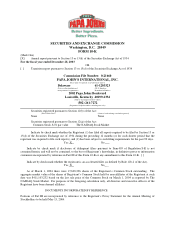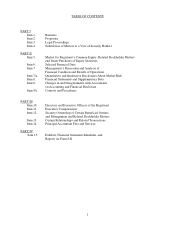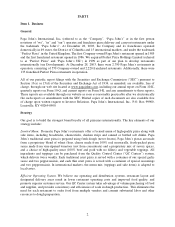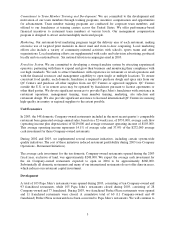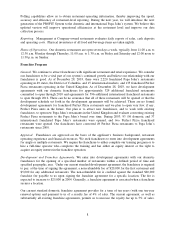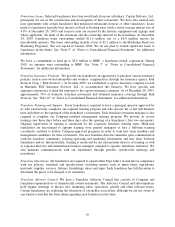Papa Johns 2003 Annual Report Download - page 5
Download and view the complete annual report
Please find page 5 of the 2003 Papa Johns annual report below. You can navigate through the pages in the report by either clicking on the pages listed below, or by using the keyword search tool below to find specific information within the annual report.
4
evaluate the conversion of the remaining 135 franchised Perfect Pizza restaurants to Papa John’s
depending on financial performance and future growth opportunities.
During 2004, we plan to open approximately six Company-owned restaurants domestically and expect
franchisees to open approximately 170 to 200 restaurants (120 to 140 domestically and 50 to 60
internationally). We also expect approximately 70 to 100 restaurants, primarily domestic franchised, to
close during 2004. Domestic and international franchise unit expansion is expected to spread throughout
markets across North and South America, Europe, Asia and the Middle East.
Our Company-owned expansion strategy is to continue to open restaurants in existing markets, thereby
increasing consumer awareness and enabling us to take advantage of operational and advertising
efficiencies. Our experience in developing markets indicates that market penetration through the opening
of multiple restaurants within a particular market results in increased average restaurant sales in that
market. We have co-developed markets with some franchisees or divided markets among franchisees, and
will continue to utilize market co-development in the future. We continually evaluate the number and
market areas of our Company-owned restaurants, and may purchase or sell restaurants from time to time.
We also have one joint venture and may consider entering into more of these arrangements in the future.
Restaurant Design and Site Selection
Backlit awnings, neon window designs and other visible signage characterize the exterior of most Papa
John’s restaurants. A typical domestic Papa John’s restaurant averages 1,100 to 1,500 square feet and a
typical international Papa John’s restaurant averages 900 to 1,400 square feet. Papa John’s restaurants
are designed to facilitate a smooth flow of food orders through the restaurant. The layout includes
specific areas for order taking, pizza preparation and routing, resulting in simplified operations, lower
training and labor costs, increased efficiency and improved consistency and quality of food products.
The typical interior of a Papa John’s restaurant has a vibrant red and white color scheme with green
striping, and includes a bright menu board, custom counters and a carryout customer area. The counters
are designed to allow customers to watch the team members slap out the dough and put sauce and
toppings on pizzas.
The Company is developing a restaurant image enhancement program that may be implemented in a
small number of Company-owned restaurants during 2004. The targeted cost of the image enhancement
program is expected to approximate $30,000 to $40,000 per inline unit and $45,000 to $60,000 per
freestanding unit. The Company has not yet determined whether to implement the image enhancement
program in other Company-owned restaurants, or whether to require franchisees to participate in the
program.
We consider the location of a restaurant to be important and therefore devote significant resources to the
investigation and evaluation of potential sites. The site selection process includes a review of trade area
demographics, target population density, household income levels and competitive factors. A member of
our development team inspects each potential domestic Company-owned or franchised restaurant
location and the surrounding market before a site is approved. Our restaurants are typically located in
strip shopping centers or freestanding buildings that provide visibility, curb appeal and accessibility. Our
restaurant design may be configured to fit a wide variety of building shapes and sizes, which increases
the number of suitable locations for our restaurants.
During the past several years, a number of freestanding restaurants have been opened in the Papa John’s
system. We seek either existing buildings suitable for conversion, or locations suitable for the
construction of our prototype restaurant. Freestanding buildings generally provide more signage and
better visibility, accessibility and parking. We believe that these locations improve Papa John’s image

